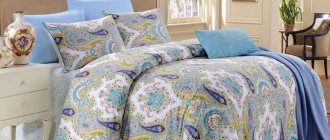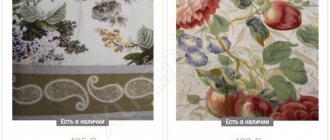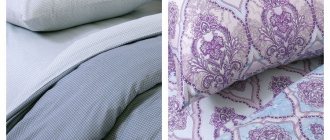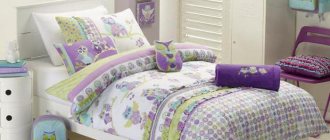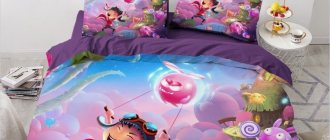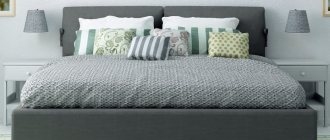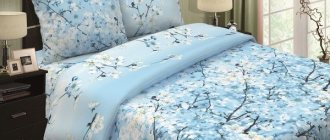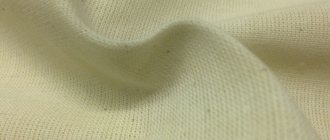What is the difference between poplin and satin
Articles on the topic (click to view)
- Fences for parking lots and parking areas
- Selection of reinforced concrete columns
- Linen bed linen: pros and cons, selection rules
- 5 ways to make your interior more expensive
- Cleaning upholstered furniture
- How to choose bed linen?
- Side for baby's crib
To choose the best quality and most comfortable bedding, you need to decide on the fabric from which the set is made.
The market offers a huge selection of sleep sets made from calico, satin, poplin, cotton, percale, linen and even silk. The most popular sleeping sets are bedding sets made from calico, but such material cannot boast of durability.
Quite often, bedding made of satin or poplin is purchased. These materials are not the same in their properties. To choose a set, you need to study the difference between poplin and satin.
What is the difference between these fabrics?
There are several criteria by which bedding sets for sleeping are selected. Let's look at the most important of them.
- Density. Poplin “wins” here. It has less density, which means the fabric is more airy and lighter. Unfortunately, poplin sometimes fades, especially when washed at high temperatures and ironed. Satin is much more resistant to heat treatment.
- Softness. In this case, all the advantages are on the side of satin fabric. This bed linen is the most delicate to the touch. In second place in terms of softness is poplin. It is softer than calico, but a little rougher than satin.
- Tactile sensations. Satin comes first again. Pleasant as silk, the unusually soft cool fabric gives extraordinary sensations and peace.
- Drawing. On satin fabric, the pattern is obtained by interweaving threads that are pre-dyed. Poplin is able to preserve for a long time a design applied by dyeing ready-made fabric or printing an image on it.
After the differences between poplin and satin have been clarified, you need to find out what these materials have in common.
Satin and poplin: what do they have in common?
Bedding materials, in addition to differences, also have some similar characteristics. Let's look at a few of them.
- Thermal conductivity. Sheets, pillowcases, and duvet covers made of satin or poplin have high thermal conductivity. In inclement weather, they warm the body; in the summer heat, underwear gives pleasant cooling to the skin.
- Air permeability. Both satin and poplin have excellent breathability, so a body covered with underwear made from such fabric will “breathe” freely.
- Hygroscopicity. This characteristic is inherent in both fabrics under consideration - both poplin and satin. They absorb moisture well, leaving no signs of sweat on the human body during sleep.
- Wear resistance. Linen made from such materials does not form pills, and bedding is not subject to shrinkage after washing.
- Environmentally friendly materials. Satin and poplin underwear are made of environmentally friendly fabric that does not harm human skin and does not cause allergies.
- Durability. Sets made of satin or poplin can serve for a long time without harming their appearance or qualities.
Attention! Poplin linen can withstand more than 200 washes at 30 degrees, and satin - from 300.
Choosing bed linen: main characteristics
To make the right choice in favor of one material or another, you should delve into the study of the basic properties of fabrics.
Percale is a fabric that originates from India. The name is translated from Persian as “rag”. The fabric is made from natural cotton fibers, which are combed in a certain way and only after that the material is woven. Percale is distinguished by plain weaving, which ensures high strength of the fabric. That is why such material was previously used to make ship sails. The finer type was used to make clothing and bedding items.
For your information! Previously, parachutes were made from percale, which confirms the high strength of the material, as well as products made from it.
Percale fabric
Poplin became popular in the 14th century. Translated from Italian it means “papal”. The fabric owes its name to its place of origin. Poplin was first made in Avignon, where the residence of the Pope was located. Initially, it was made from silk, the reverse side was plain, and the front side was covered with ornaments.
Note! Today, poplin is produced by plain weave of cotton or synthetic fibers with weaving threads of different thicknesses. This causes the presence of small scars on the surface of the canvas. Weaving with synthetics in its composition, in turn, negatively affects the characteristics of the finished fabric, complicating the air exchange of the sheet or duvet cover.
Poplin is often used for sewing men's and women's clothing, curtains, and towels. It comes in different types. The composition may contain silk or wool fibers. This type of fabric is typically used to make high-quality sheets, pillowcases, and duvet covers.
Poplin fabric
The main characteristics of bedding material include:
- High performance. The fabric must be wear-resistant. For example, bed linen made from percale will last at least 7-8 years, and from poplin - 4-5 years.
- High density provides wear resistance. The density of percale and poplin is almost the same - up to 150 g/m².
- Repeated washing and ironing should not affect the quality of the fabric in any way; it remains durable and bright.
- Percale or satin does not form pellets on the surface, does not deform, does not stretch or shrink.
- When producing bed linen material, untwisted cotton fibers should be used, due to this the surface of the fabric is soft and smooth.
- Percale is able to maintain body temperature. Products made from it do not cool in the cold and allow the skin to breathe in hot weather.
- Easy to care for. Percale, for example, wrinkles a lot and requires high-quality ironing and steaming.
You may be interested in: What fabrics are used to create children's bedding
Natural fabrics for linen
Many people are interested in how percale differs from calico. The fundamental difference is the thread density: for percale it is up to 150 g/m², and for calico up to 125 g/m². Also, fabrics differ in their service life and fading after several washes. In this case, percale is superior to calico: it will last longer and retain its original shades.
What is better to choose for bed linen
The stores offer an incredible number of bedding sets for sleeping in various colors and from a variety of materials. Both adult and children's sets are presented in the form of calico, cotton, satin, poplin linen, as well as percale and a relatively new material - bamboo.
The following factors should influence the choice of the best set for a comfortable sleep:
- price;
- durability;
- colors;
- material;
- compound;
- tactile sensations.
It is quite possible to choose bed linen that meets each of these parameters, based on personal financial capabilities and leisure preferences.
Advantages and disadvantages of fabrics
Each material has its own pros and cons, which are the determining factors when choosing bedding. Let's look at them using the example of satin and poplin bedding sets.
Pros and cons of satin lingerie
Satin as a material for bedding sets has many advantages over other types of fabrics.
- Appearance. Such products are very similar to silk, the many colors are amazing. This material is considered an elite fabric.
- Easy to care for. Products made from this material are very easy to iron and practically do not wrinkle. After washing, satin does not shrink.
- Pleasant to the touch. With tactile contact you can feel the pleasant coolness of satin, similar to silk.
- Safe for human skin. Absolutely hypoallergenic material, it is ideal for those with very sensitive skin.
- Durability. Satin bed linen can withstand more than 300 washes without losing color or quality.
In addition to such excellent qualities, this material also has disadvantages.
- The main disadvantage of satin is its high price. A set of bedding made from this fabric is much more expensive than sets made from poplin, calico, bamboo and others.
- Although the fabric is quite breathable, it is not recommended for use on very hot nights as this may cause sweating as well as discomfort.
- Due to the fact that the material is very slippery, it is best to sleep on sheets made from it in pajamas.
However, all these disadvantages relate more to individual shortcomings.
How to wash calico, satin, poplin
Strictly following the instructions for caring for a product of a certain type will extend its service life. For cotton fabrics, the following recommendations should be observed:
Calico
Snow-white bedding is washed at temperatures up to 60°C using powder for natural whites. Colored laundry should be washed at a temperature not exceeding 45°C, after first turning it inside out. Spinning should be done at 600-800 rpm.
Note! Since calico is difficult to iron, it is better to do this while the linen is damp. If the product has embroidery, it is ironed from the reverse side, in all other cases - from the face.
Calico for bed linen
Satin
Satin bed linen is washed at a temperature of 40-60°C. When choosing a washing powder, you should pay attention to the content of bleaching components, which can negatively affect the appearance of colored fabrics with a pattern, embroidery or print.
You may be interested in this Interesting facts about printed fabrics
The exception is pure white textiles. After washing, it is recommended to additionally rinse the laundry in cold water. It is advisable to select the minimum spin in the machine so that the fabric does not shrink. It is better to iron products in a semi-dry state.
Satin after washing
Percale
If products made from it are washed for the first time, the water temperature should not exceed 20°C. For subsequent washes, you can set the temperature indicated on the tags, but not more than 60°C.
It is not recommended to starch a percale sheet, since as a result of this procedure it absorbs moisture less well and becomes less comfortable. Do not wash at the same time as other types of fabrics to prevent deformation of the fibers. If your machine has an additional rinse function when washing percale, it is advisable to turn it on.
How to wash percale
Poplin
For minor stains, it is recommended to wash poplin products by hand. Warm water at 30-40°C is taken into a basin and the powder is dissolved in it. The product is immersed in the liquid and soaked for 20 minutes. Use gentle movements to wash, paying special attention to areas with severe contamination. Then the product is rinsed twice with cool water and, after squeezing lightly, hung out to dry.
Poplin is machine washed at 40°C. If the fabric contains synthetic, silk or woolen threads, washing is done at a temperature of 30°C on a gentle cycle, and spinning is limited to 600 rpm.
If all recommendations are followed, long service life and comfortable sensations when using cotton underwear are guaranteed by the manufacturer.
Ironing poplin
